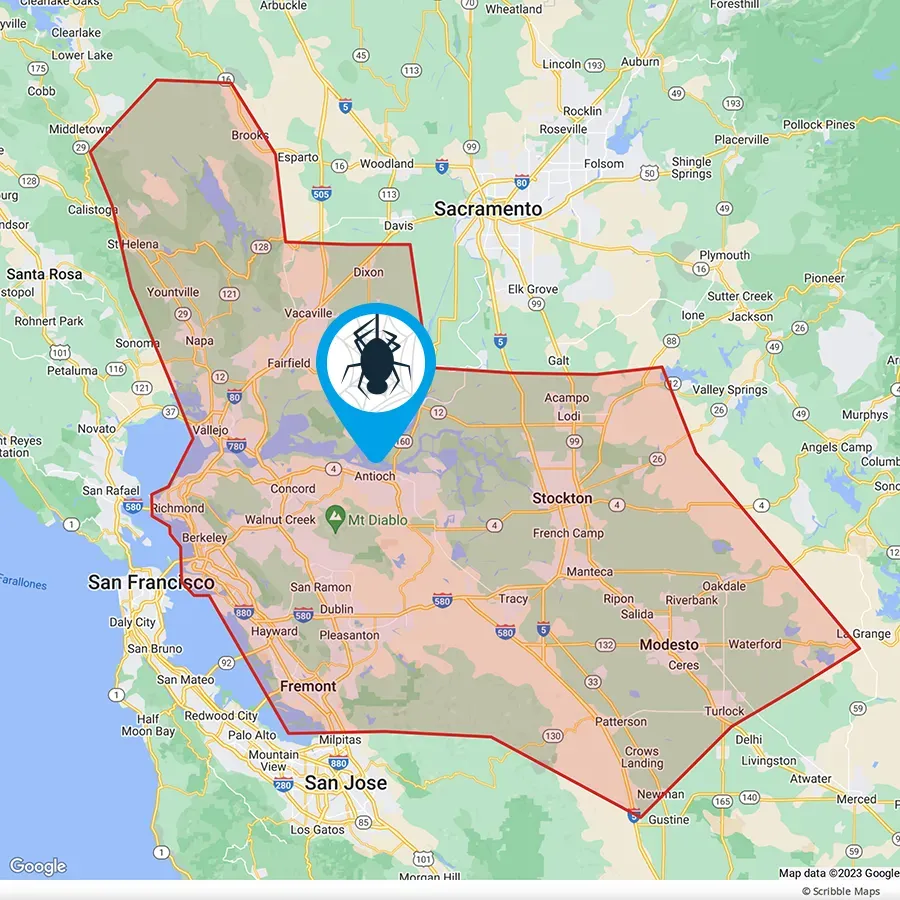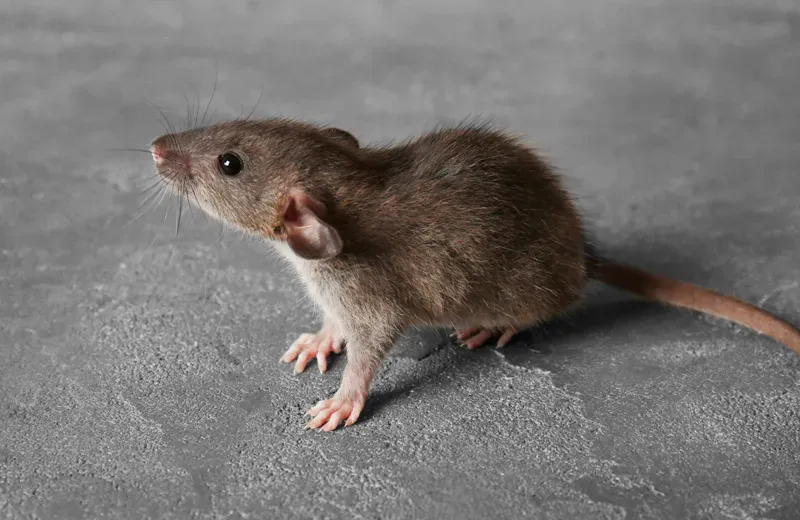Rodent Control in Antioch, CA
Our team of Diamond Certified Pest Control Experts have helped many families just like yours live rat free. Contact us online or by phone to set up a rat control program that works for you and your family.
Common Signs of Rodents
Tracks & Stains
When rats run along floors, window sills, counters, or anything else inside your home, dirt and grease stains accumulate. The more active rats there are in your home, the darker the stains will be.
Rat Droppings
One of the most common ways to know you have a rat infestation is to find their droppings. They are small and capsule shaped, and can be found in the same areas as dirt and grease stains.
Gnawing Marks
Cut electrical wires, chewed up objects, and damage to insulation in your home can be a sign that you have a rat infestation. Damaged landscaping and gardens can also indicate whether or not there are rats on the premises. Don’t forget to check under the hood of your cars!
Burrows and Sightings
Rats generally only come out at night. If you see a rat during the day, odds are that you have a large infestation. Burrows outside and around your home could be their nests.
Call Now For A Free Inspection
How Rats Get Inside Your Home
Though it might seem like your home is closed off from rats, there are many ways they can get themselves in. Rats can fit through very small holes, climb, and chew their way into your home. They also have many places to hide such as attics, garages, crawl spaces, basements, and more.
A rat’s bones are flexible and small. Their bones (excluding their skull) can shift to fit through small spaces. If their skull can fit, they can fit! This flexibility allows rats to fit through holes the size of a quarter, and some can fit through a hole the size of a dime.
Rats can also climb to very high spaces to get inside your home. This includes using tree branches and the roof as access. They can fall from five stories without getting injured!
Health and Safety Risks that Rats Pose
Unlike other pests such as spiders where some are can be harmless to humans, all wild rats can be harmful. Rats often carry diseases and parasites that can affect adults, children and pets. These diseases can be transmitted through rat bites, droppings, contact, or food contamination. Seeing one rat indicates that there are more, as rat populations prefer to live in colonies.
Disease
Rats can carry and spread diseases such as salmonella that can lead to food poisoning. Rat droppings can also trigger asthma and allergic reactions. Rats can host parasitic insects that carry and transmit their own diseases. These parasites include fleas, mites, lice, and ticks which can cause health issues for adults, children or pets.
Damage to home
To get inside your home, rats will dig and chew through electrical wires, belongings, exterior foundation, insulation, and more. Older homes and buildings with poor construction and maintenance are more susceptible to rat infestation. Common rat behavior suggests that they are also attracted to gardens, uncut grass, and thick shrubs.
Common Rats in California We Eliminate for You
There are two main species of rats found in the United States. The majority of states have only one species, the Norway Rat. The other fraction of states have two, both the Norway rat and the Roof Rat; California is one of them.
The Norway Rat (Norwegian Brown Rat) is one of the largest rat species to exist, and they like to be lower to the ground when getting into homes. These rats primary food source are proteins and greasy foods like meat and dog food. The Roof Rat, as the name implies, likes to be higher up in the air and generally gets into homes by tree branches, power lines, and the roof. The Roof Rat is smaller than the Norway Rat, and these rats eat foods like fruits and vegetables.
Differences at A Glance:
- Color
- Norway Rat: brown or dark gray rat with light gray/brown belly
- Roof Rat: dark brown or black rat
- Nose
- Norway Rat: thick and blunt
- Roof Rat: thin and pointed
- Ears and Eyes
- Norway Rat: small
- Roof Rat: large
- Tail
- Norway Rat: shorter than head and body
- Roof Rat: longer than head and body
- Body
- Norway Rat: thick and bulky, one of the largest rats
- Roof Rat: thin and slender
It is important to note that there are other subspecies of rats that also exist in California. Rats that could be found in our service counties include:
- Hispid Cotton Rat – Black or dark brown in color, back is a dark brown and beige mix, and a grayish white belly. Tail is darker on top, lighter on bottom, and shorter than body.
- Kangaroo Rat
- Ord’s Kangaroo Rat – Colors can vary from dark gray, gray-tan mix, brown or light orange. Sides have a light stripe (tan or yellow) and they have a white belly. White spots above/below the eyes and behind the ears. Furry tail with black tip. Five toes on hind feet.
- Heermann’s Kangaroo Rat – Medium-sized and can be a yellow-gray mix, yellow-brown mix or a dark black-brown mix in color. Sides are lighter in color (tan, yellow, orange brown, dark orange) and belly is white. Faint spots near the eyes and behind the ears. Striped tail with black tip. Five toes on hind feet.
- California Kangaroo Rat – Larger and darker colored than other Kangaroo rats (dark gray or orange-brown). White spot above eyes and small spot below ears. Four toes on hind feet.
- Desert Woodrat – Colors are gray to a gray-brown mix on the back, and sides are tan or pale orange. Belly is white, and tail is covered with short fur and is shorter than body.
Our Diamond Certified Rat Control Strategy
Free Rat Inspection and Estimate
A Rat Control Specialist will arrive at your home within 24 hours of your initial call. They will assess the degree of the rat infestation and offer the best treatment solution.
Exterior Rat Exclusion Treatment
Your specialist will identify, seal, and monitor any access points outside that allow rats to enter your home.
Rat Trapping and Removal
Though entry points will be sealed, it is important to make sure that the rats are captured from both inside and outside. Rat traps and bait stations are placed in common places where rats are found including basements, attics, crawl spaces, and also the exterior of the home to keep the closed off entry points sealed. These rat traps are secured with a lock and therefore can be used safely in the presence of children and pets.
Follow-up Rat Inspection & Monitoring
A specialist will return every 7-10 days to ensure that the treatment is effective. These visits include the specialist removing any trapped rats or dead rats from the premises and making sure that entry points have remained sealed. This process can take 4-6 weeks depending on the degree of the rat infestation.
Successful Completion of Treatment
Once there are two consecutive weeks of inspection without any signs of rats on the premises, the treatment is complete. This means that there will be no rats in any of the traps, no new or reopened entry points, and no new traces of rats (i.e. new droppings, noise in house, dirt trails, etc.)
Continued Rodent & Pest Control Maintenance
While it appears sealing entry points can be done without an exterminator, it is highly advised to reach out to one of our specialists to ensure safety to your family. Signing up for the All N One Rodent Control & Maintenance Package allows our specialists to make regular visits to your home and keeps it protected all year-round.
Prevent future rat infestations by:
- Fixing plumbing leaks
- Sealing containers (e.g. garbage cans, pet food)
- Blocking potential access points (e.g. closing windows and doors)
- Trimming tree branches away from home
- Removing possible water and food sources
Over the Counter Rat Control Solutions and Limitations
With all of the “at home” methods to get rid of pests, controlling rats may seem like a simple job. However, many of the products used can be ineffective, unsafe, or cause even more issues.
Some of the most common over-the-counter rat control products are:
Setting traps
- Glue traps: These traps do not kill rats and mice. Instead, they catch and trap the rodents from escaping. One main issue with these is that the rat will still be alive until you either release it, kill it, or let it die on its own; which can take days or longer. If trapped, rodents typically make a lot of noise which can be very bothersome. Also, trying to remove dead rats from your home is unsafe if not done properly.
- Snap traps: These rat traps are effective in catching and killing rats, but also are unsafe around children and pets. Snap traps can only catch one rat at a time, which means buying more and more rat traps. Since rats live in large colonies, it is unlikely that a few trapped rats indicate the rat infestation is solved.
Poison baits
These can be effective but also have many limitations when it comes to the efficiency of getting rid of rats. Poison slowly kills the rats, and when they do die it is uncertain where inside your home they will be. Many rats live behind walls or in unreachable places. If they die in those places, getting rid of the rats would be even more difficult. Poison can also be unsafe around children and pets.
Rat repellents
These can be helpful in keeping rats away from your home as a preventative measure but will not make your home “rodent proof.” If you notice rats around the outside of your home, a rat repellent can help ensure that the rats do not become a bigger issue.

Rodent Control Service Area
All N One Pest Eliminators proudly serves customers in Northern California. Our experienced exterminators are capable of providing safe and effective pest control services to any location in our service area. Our service area includes the following:





